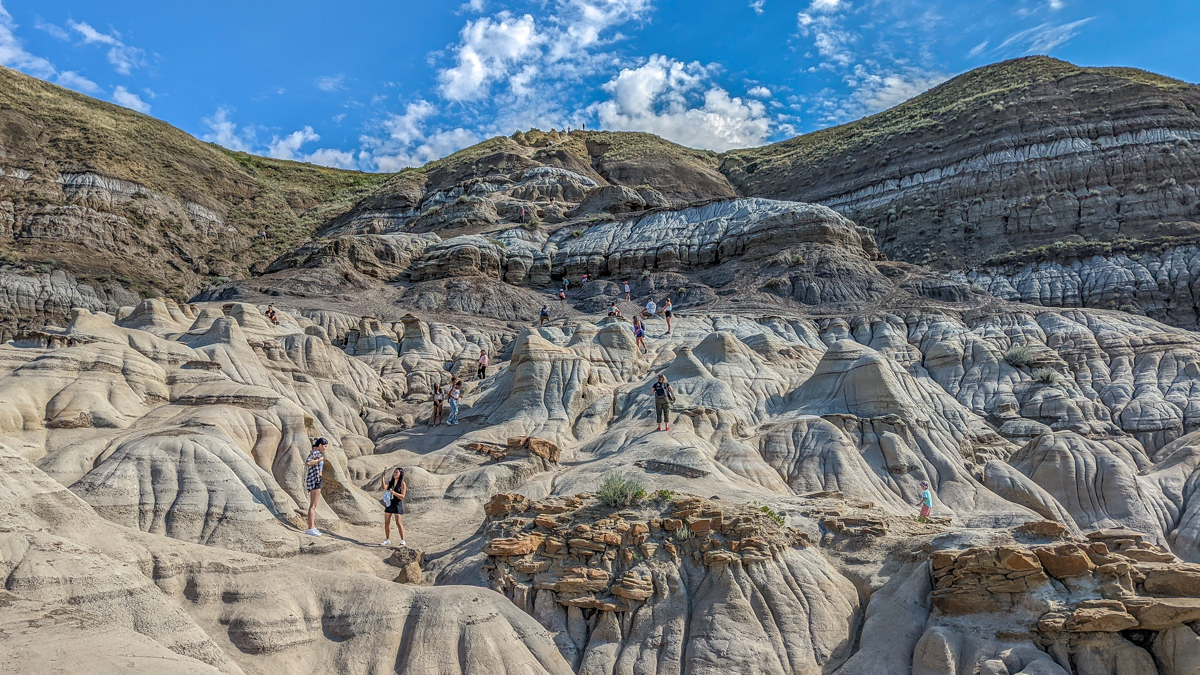Tucked within the arid beauty of Alberta’s Canadian Badlands lies a small but mighty wonder—Hoodoos Trail in Drumheller. Though the trail itself is short, spanning just under 0.5 kilometers round trip, the experience it offers is nothing short of magical. The star attractions here are the hoodoos, surreal sandstone spires that rise from the desert-like earth, shaped by millions of years of erosion. These formations, often described as “fairy chimneys” or “stone mushrooms,” offer a glimpse into both geological history and natural artistry.
What sets Hoodoos Trail apart from other hikes is its accessibility, family-friendliness, and visual impact. Within just 20–30 minutes of gentle walking, visitors are transported into a prehistoric world filled with towering stone sculptures, framed by the stunning backdrops of rolling hills and layered cliffs. It’s a perfect stop for a spontaneous road trip, a quick detour from the Royal Tyrrell Museum, or an introduction to the wonders of the Badlands.
Whether you’re a geology enthusiast, travel photographer, hiker, or simply someone looking for a beautiful place to stretch your legs, Hoodoos Trail is a must-see gem in Southern Alberta that promises both awe and education with every step.
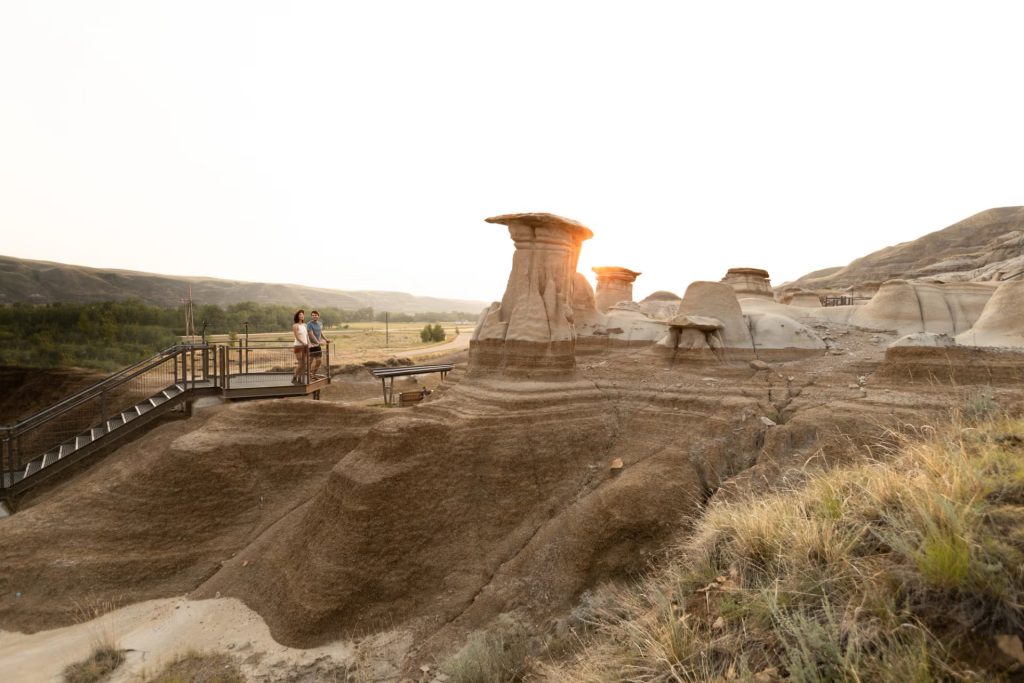
What Are Hoodoos? A Look at Nature’s Sandstone Sculptures
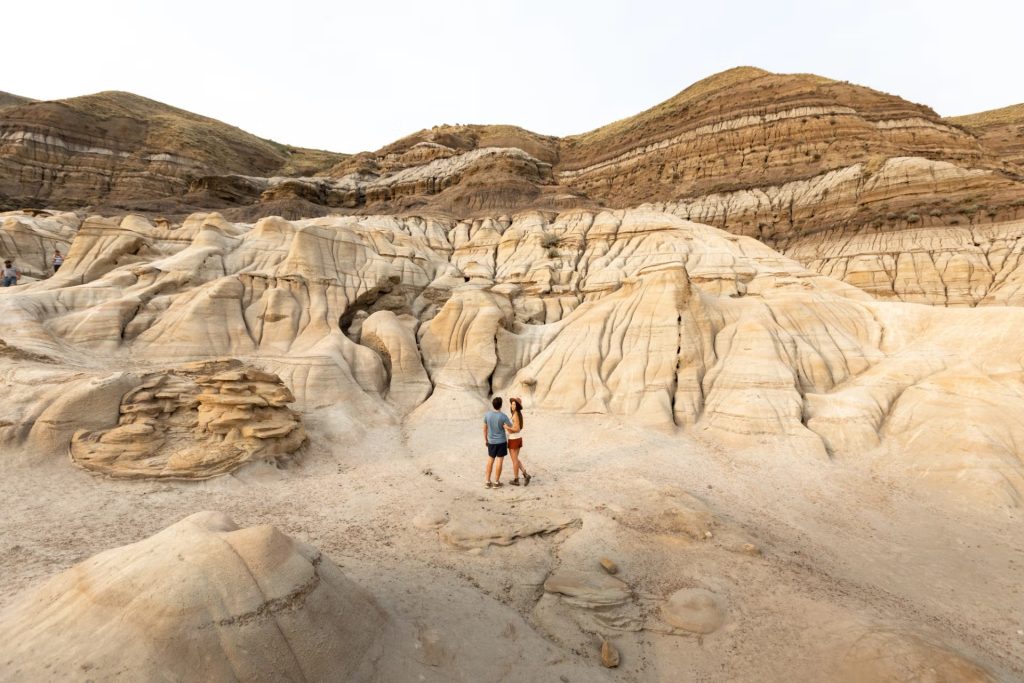
The term “hoodoo” refers to a naturally eroded rock column formed from soft sedimentary rock like sandstone, topped by a harder capstone that resists erosion. These unusual pillars are shaped by centuries of wind, rain, ice, and frost, gradually sculpting the softer base while the protective cap delays weathering at the top. The result? Towering stone formations that resemble totems, mushrooms, or even stacked cones, rising from the dry landscape.
At Hoodoos Trail, these formations reach up to 20 feet tall and stand prominently against the pale, rugged backdrop of Alberta’s Badlands. Some of the hoodoos found here are estimated to be over 70 million years old, formed from sediment deposited during the Late Cretaceous period. Their colors—soft beige, ochre, and orange—change beautifully under shifting light conditions throughout the day.
Culturally, hoodoos carry spiritual meaning for many Indigenous groups. Some First Nations believed these formations were petrified giants that came to life at night to ward off intruders. These ancient beliefs add a mystical layer to the natural wonder that hoodoos represent.
As a geological phenomenon, they are fragile and rare. The formations on this trail are protected, and visitors are strongly advised to avoid climbing or touching them to prevent further erosion and preserve their beauty for generations to come.
How to Get There: Access and Location of Hoodoos Trail
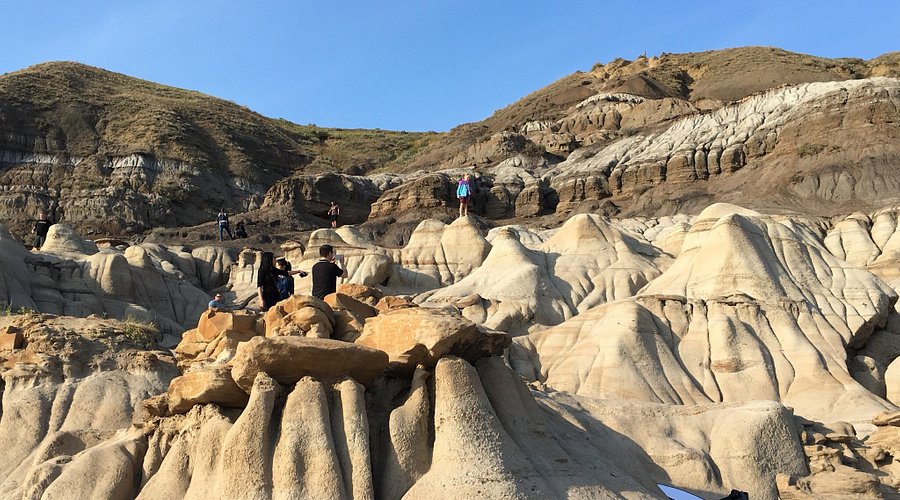
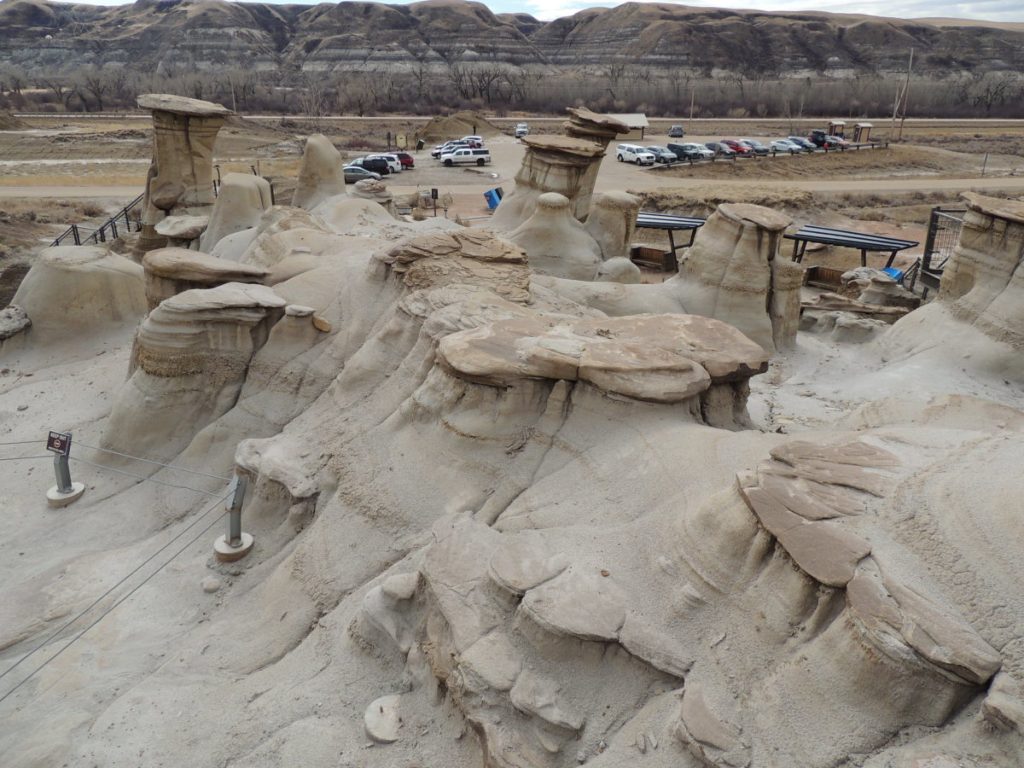
Hoodoos Trail is conveniently located about 15 km southeast of Drumheller, Alberta—making it a quick 10–15 minute drive from the town center. This makes the trail an ideal stop for both day-trippers and those exploring the area’s larger attractions, such as the Royal Tyrrell Museum or Dinosaur Trail. To reach the trail, simply head along Highway 10 East toward Rosedale. You’ll see clear signage pointing to the Hoodoos site on your right.
There is a free parking lot at the trailhead, complete with washroom facilities and interpretive signs that give context to the surrounding landscape. The site is accessible by most vehicles, including RVs, and the short distance from Drumheller means you can easily fit it into even a tightly packed itinerary.
Visitors should be aware that while the trail is open year-round, conditions vary by season. In winter, snow and ice can make the walk slippery, while summer afternoons can get hot and dry. For the best experience, aim to visit during spring or early fall, or early mornings in the summer to avoid the crowds and intense midday sun.
Trail Experience: What to Expect on the Hoodoos Walk
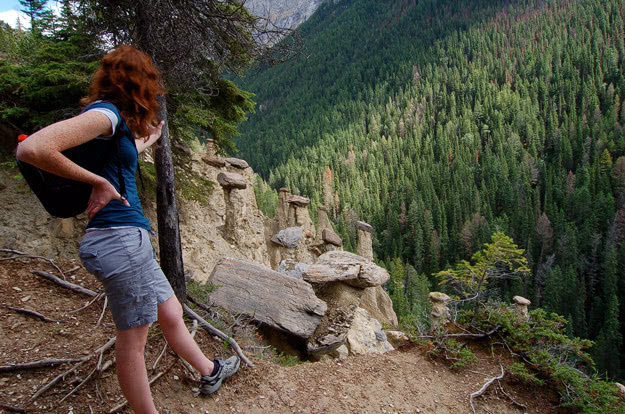
Though it’s referred to as a “trail,” Hoodoos Trail is closer to a scenic walking path—short in length but packed with visual intrigue. Spanning just around 0.5 kilometers round-trip, the trail begins at the parking lot and leads visitors up wooden stairs and gravel paths that weave through and around the rock formations. Wooden boardwalks and observation platforms help protect the fragile terrain while offering elevated vantage points for photographs and views.
Despite its short length, the trail is surprisingly immersive. You’ll be walking through a cluster of tall hoodoos with layered cliffs behind you and a panoramic view of Alberta’s Badlands stretching ahead. Interpretive signs along the path explain how the hoodoos were formed, their geological significance, and the history of the surrounding area.
The trail is suitable for all ages and skill levels. Kids enjoy climbing the staircases and marveling at the giant “stone mushrooms,” while adults can appreciate the geological history and natural architecture. It’s not wheelchair accessible due to the stairs, but visitors with some mobility challenges can still enjoy the view from the base.
Time required: About 20–30 minutes, though you may want to linger longer for photos or simply to enjoy the peaceful surroundings.
Best Times to Visit: Seasons and Tips for a Great Experience

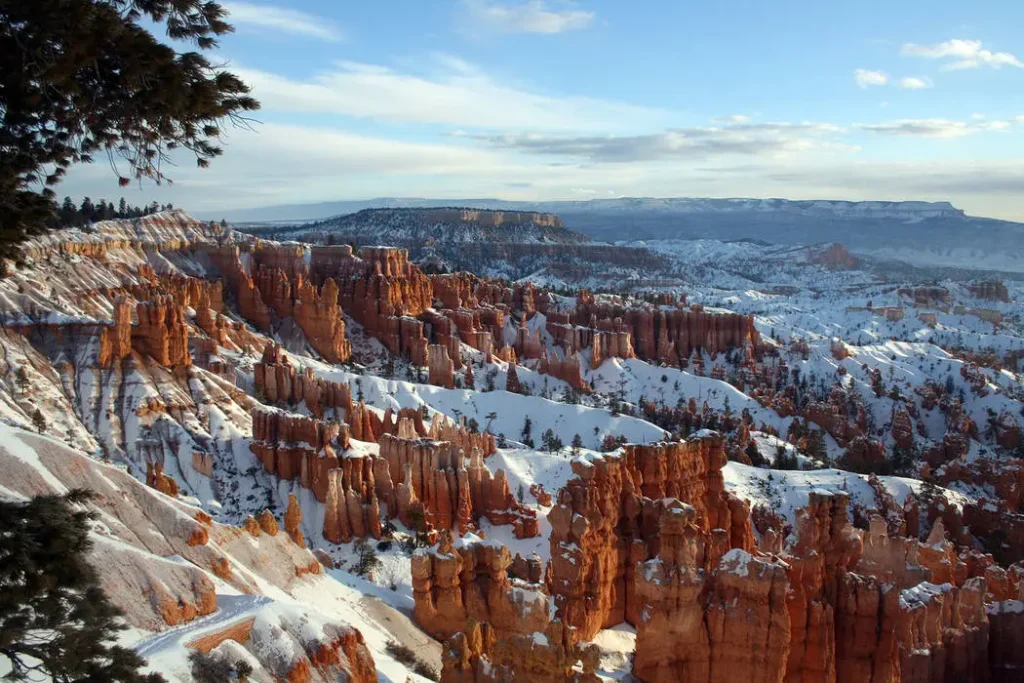
Choosing the right time to visit Hoodoos Trail can make a big difference in your experience. The peak season is between May and September, when the weather is dry, skies are blue, and the trail is easiest to walk. These months also see the most visitors, especially during weekends and holidays, so plan your timing carefully if you prefer solitude.
Seasonal Breakdown:
- Spring (April–June): Ideal temperatures and fewer crowds. Wildflowers begin to bloom, adding color to the surrounding Badlands.
- Summer (July–August): Warmest months with the highest visitor volume. Visit early morning or after 5 PM to avoid the heat and crowds.
- Fall (September–October): Cooler and quieter, with beautiful soft light—perfect for photography.
- Winter (November–March): Trail remains open but may be icy. Beautiful in the snow but requires extra caution and appropriate footwear.
Best time of day: Aim for sunrise or sunset. The hoodoos catch golden light beautifully, and the shadows cast across the landscape create an almost lunar effect.
Bring plenty of water, sunscreen, and a hat, especially in summer, as there is very little shade along the trail. Dress in layers if you’re visiting in spring or fall, and always wear comfortable walking shoes with good grip.
Tips for Visitors: Making the Most of Your Visit
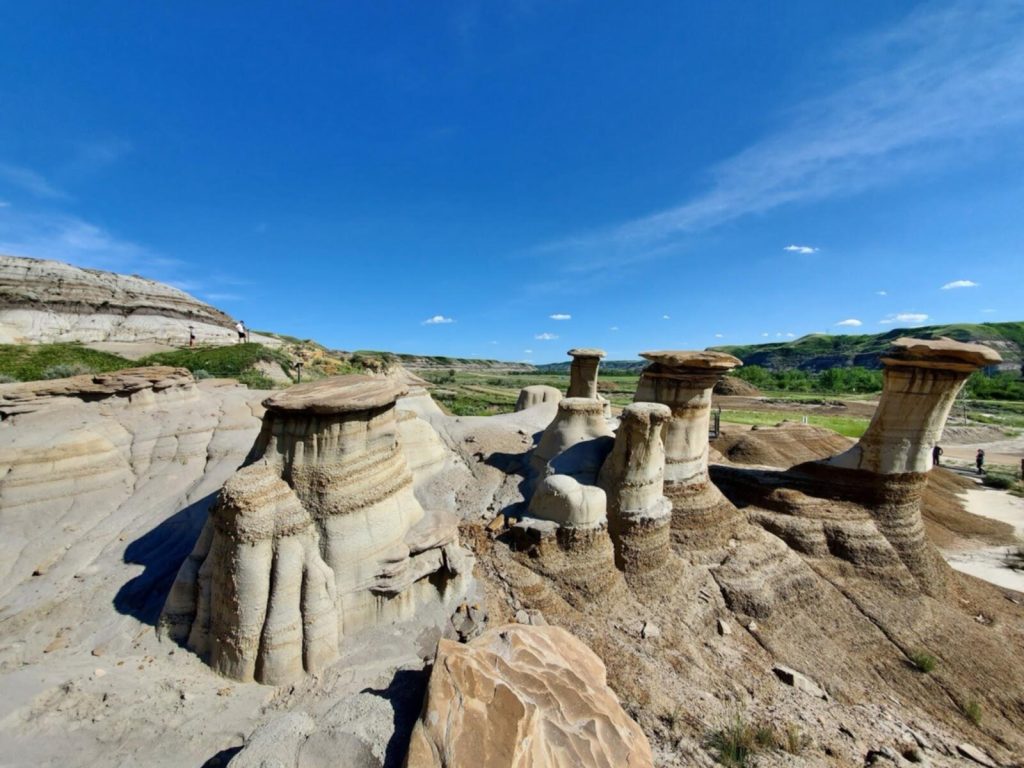
To make your experience at Hoodoos Trail even better, follow these local and traveler-approved tips:
- Don’t Climb the Hoodoos: They may look sturdy, but the soft sandstone erodes easily. Climbing them can permanently damage the formations and is prohibited.
- Take Your Time: Even though it’s a short trail, slow down and explore all the different angles. The view changes dramatically with every few steps.
- Bring a Camera or Smartphone: This trail is extremely photogenic. Wide shots, close-ups of the sandstone textures, and silhouette shots during sunset are all worth capturing.
- Pack Light but Smart: Water, sunscreen, and your phone/camera are must-haves. A small daypack is ideal.
- Combine with Nearby Attractions: Make a full day out of your visit by including the Royal Tyrrell Museum, Atlas Coal Mine, or Horseshoe Canyon in your itinerary.
Lastly, be mindful of your impact. This ecosystem is fragile and irreplaceable, and responsible tourism helps preserve it for future generations.
Nearby Attractions: Extend Your Badlands Adventure
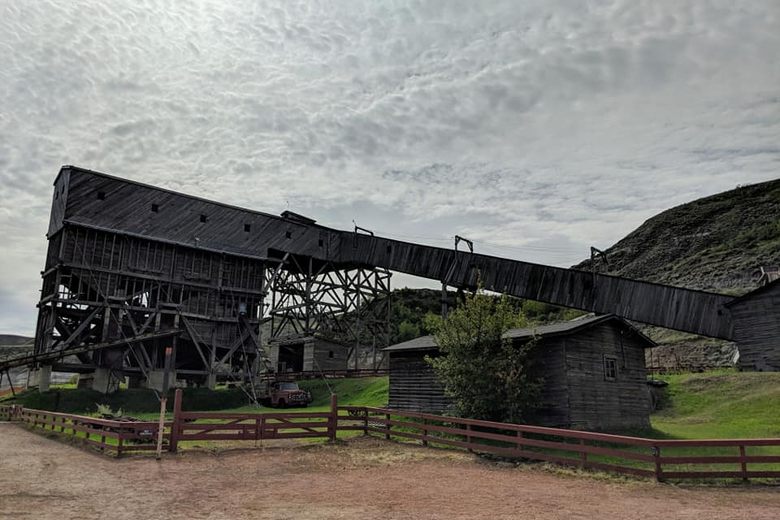
The Hoodoos Trail is just the beginning of the adventure in this part of Alberta. Drumheller and its surroundings are filled with exciting attractions for nature lovers, history buffs, and families. Consider adding these stops to your trip:
- Royal Tyrrell Museum – Home to one of the world’s largest collections of dinosaur fossils, this museum is a must-see for visitors of all ages.
- Atlas Coal Mine – Explore Alberta’s industrial past with a tour of this preserved coal mining facility, complete with underground tunnels and tipple climbs.
- Horseshoe Canyon – A short drive from Drumheller, this U-shaped canyon offers incredible panoramic views and is perfect for a light hike or picnic.
- Dinosaur Trail – A scenic driving loop that takes you through winding hills, viewpoints, and even across a ferry ride on the Red Deer River.
- The Little Church – A charming miniature chapel that holds only six people at a time, it’s a fun, quirky stop just minutes from the museum.
Conclusion: Add Hoodoos Trail to Your Bucket List
The Hoodoos Trail offers more than a walk among cool rocks—it’s a walk through time. In just under half an hour, you’ll experience millions of years of geological history, take stunning photos, and discover a rare natural phenomenon in one of Canada’s most underrated landscapes. It’s a short, unforgettable journey for every type of traveler—from families and school groups to road-trippers and solo adventurers.
Whether you’re a geology geek, a weekend wanderer, or just someone looking to reconnect with nature, make sure to carve out time for Hoodoos Trail. It’s a postcard-perfect piece of Alberta that proves you don’t need a long hike to find something truly spectacular.

